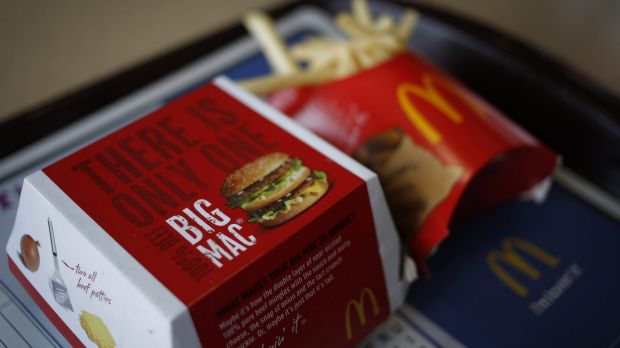
Booming: McDonald’s home delivery service is proving successful in Sydney. Photo: Bloomberg
McDonald’s is now delivering to homes in more than Sydney 50 suburbs, with fellow fast food giant Red Rooster joining in the lucrative meal delivery market.
Over the past year, the burger chain has expanded its Sydney footprint from one store delivering to four suburbs, to seven stores delivering to 53, raising concerns among anti-obesity groups.
Red Rooster launched a home delivery service from its Baulkham Hills store in Sydney’s north west last year, since expanding to four other sites at Glendenning, St Clair, Lismore and Armidale.
The McDonald’s service, dubbed ‘McDelivery’, is one the fast food giant’s latest strategies to remain relevant, on-trend, and profitable, experts say, while so-called “fast casual” chains such as Grill’d and Nando’s attempt to take away its market share.
The breakfast and lunch menus on the Menulog site, the online platform McDonald’s is using to run its delivery service, now features in total more than 120 items – excluding the meal deals.
“It is all about offering choice and convenience. We are always innovating to meet our customers’ changing needs,” a spokeswoman for McDonald’s said. “As we see in our restaurants, McDonald’s famous Big Mac has been the most popular item for home delivery.”
The Parramatta trial, first reported by The Sun-Herald in December 2013, was such a success that the service has been expanded into four states. This year, McDonald’s plans to double the number of Queensland stores doing delivery to 40.
Brian Walker, founder of the consultancy firm the Retail Doctor, said McDonald’s – which late last year posted its worst sales in 10 years – home delivery move was a sign it was seeking to “re-energise, re-innovate and redevelop”.
“The timing shows it is all about keeping market share, keeping growth, staying relevant to the millennials (who are less interested), and being relevant to the new generation of fast food eaters,” he said.
Red Rooster’s national marketing manager Anna Jones said home delivery was an obvious way to extend the brand, which is primarily a drive-through service.
“The trends are there. We know people want convenience but they also want wholesome food,” she said.
“Home delivery has gone well so far. We have a couple of test markets now so we’re trying to understand the demand.”
But senior policy adviser with the Obesity Policy Coalition Jane Martin raised concerns that making fast food more accessible through home delivery could be detrimental for a country where two-thirds of the adult population is overweight.
She said home delivery was driven purely by a commercial imperative to maintain sales in the face of an ongoing push for healthier lifestyles.
“They’re under pressure,” Ms Martin said. “Their market is not growing as fast as it has previously. There have been numerous successful campaigns to raise awareness about the risks of poor nutrition and that is reflected in their sales.”
